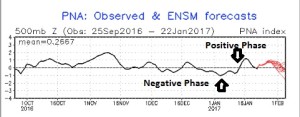The weather in Nederland and the Central Rockies, like most places on Earth, is influenced by global wind circulations. You can imagine these circulations as great atmospheric rivers of air which steer storms and push warm and cold masses of air around the world. Truly, weather forecasting often begins by examining these global weather patterns because they determine how storms move and where precipitation falls.
Much of the Western United States has been experiencing colder and stormier than normal conditions over the past several weeks. This has led to some incredible snowfall totals in California and has boosted the overall Colorado snowpack to over 150% of normal in many parts of the state. Often times, when it is colder than normal in the western United States, it is warmer than normal in the eastern United States. The converse is also true. When it is cold and stormy in the eastern U.S., it is often warmer and drier in the West. This is not a coincidence, and atmospheric scientists have studied this “pattern” and actually have a name for it. What’s that name you ask? The Pacific/North American pattern, more affectionately known as the PNA.
The PNA has two phases – a positive phase and a negative phase. The diagrams below show the jet stream’s position in both phases. In summary, a positive phase PNA means:
- Warm in the West and cold in the East
- The jet stream and storm track are well to the north of Colorado, leaving the state warmer and drier
- This type of pattern is common in January
- Not so good for Colorado snow-lovers
A negative phase PNA means:
- Cold in the West and warm in the East
- The jet stream and associated storm track dip across the western U.S. bringing cold air and copious amounts of precipitation
- Great for Colorado snow-lovers

The PNA pattern can persist for weeks at a time. Weather forecast models are not always good at predicting when the pattern will shift or change.
The National Weather Service’s Climate Prediction Center monitors the PNA and produces forecasts for it.

As you can see in the PNA chart, from late December through mid January, the PNA has been in a negative phase which corresponds nicely to the cold and wet weather in Colorado and the West. The forecasts are showing a return to a negative PNA phase by early February which could mean a return of snow and cold. We’ll see!
There are exceptions to every rule, and the PNA is no exception. Sometimes during a positive phase PNA, the jet stream and storm track can still clip Colorado, especially the Front Range, resulting in cold and snow while farther west in places such as Utah, Nevada, and California, it remains warmer and drier. Overall, though, the negative phase is a positive thing for us, especially if you like winter weather.